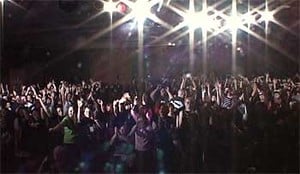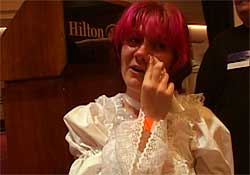Buried Treasure
Psycho Le Cému in USA
by Justin Sevakis,

Over the years, countless people have suggested I either make or license a documentary on American anime fandom. This is a very bad idea. First of all, the anime scene is so complicated - comprising of inside jokes covering hundreds of series most Americans have never heard of - that explaining it all to someone new would quickly bore them to tears. There's no point in showing such a documentary to the fans themselves, as new anime comes out all the time and the material would quickly date itself. Every attempt I've seen so far at a project like this is horribly dated, incomplete, and painfully dull.
But the fact remains, the anime scene is fascinating… in an absurdist, anthropological sort of way. No explanation needed - we're a bunch of freaks who like to dress up, spend money and get really really riled up over Japanese stuff. You needn't learn everything about us - you just need to go to a con and look around a bit.
Strangely, the one film that got this right isn't about anime fans at all. It's a concert video. And the band is called "Psycho Le Cemu."
Buried Treasure #2: Psycho Le Cemu in USA: Live & Document

For those who weren't into the con scene back in 2004, Psycho Le Cemu was a J-Rock band with a very unique hook: they were cosplayers. The costumes were original, sci-fi works of art that changed several times every performance. And when they weren't behind instruments, they danced the para-para. They were gimmicky, sure, but they were LOADS of fun. The music was approachable, bouncing between high tempo dance J-pop and full-out hard rock. And - oh yes - one of them was a complete pink-haired miniskirted cross-dresser.
Some music videos are still on YouTube, here, here and here. And here.
Founded in 1999, Psycho Le Cému started off an indie rock band, and was quickly signed to the Visual Kei management team Sweet Heart (who also manages acts like Luna Sea and Pierrot). Their music, melodic J-rock and J-pop, was much more friendly and familiar-sounding than most Visual Kei bands. But of course, it was their costumes that took center stage. Early experiments had the entire band performing in bear suits, and their eventual look settled into RPG-style fantasy. Some later costume sets took on more of a feudal Edo-Period Manga sort of style. The music videos reinforced this image with hardcore sci-fi and fantasy monster special effects. The videos were always tongue-in-cheek, often crossing the line into outright parody.

The band members - all of them "pretty" young males - each had their own roles to play. Lead singer Daishi was the charismatic "Son Goku" figurehead (i.e. the stereotypical shonen anime hero). Guitarist Aya was the cute pink-haired and mini-skirted girl. Drummer Yura-sama was the vain, mystic prince. Lida, the lead guitarist and composer, was the "sidekick," and often just blended into the background. And the bassist, Seek... well, he's the monster. Between the five, they're practically a sentai troop.
Something this bizarrely Japanese, of course, has to filter into anime fandom at some point, and as the act gained momentum in Japan (selling out some very large concert venues), they slowly found themselves attracting more and more attention from American fans. The fans, of course, were usually anime otaku, about 70% female teenagers (who were quite enthusiastic on blogs and the like.) At some point, someone got the bright idea to try to shop this band (who had a fairly sizable following in Japan) to this audience in a more official way. Online retailers and dealer room mainstays House of Anime/JpopHouse.com sponsored a small North American tour, which was really just two anime conventions: Project A-kon in Dallas and fledging AX-spinoff Pacific Media Expo.
This video documents these two concerts, the panels, and the band's reaction to all of these strange gaijin. We spend a fair amount of time with these fans that, most Japanese would think, really couldn't possibly know about a band like this.
 We don't need to know about every character in Bleach, Naruto and Rurouni Kenshin. The band, this bizarre, flashy group of genki energy, provides everything anyone would need to know. The fans, seeming to average in age around 18 and most of them caked in layers of face paint and hair dye, engage in a playful one-on-one with the camera, showcasing everything that's, frankly, awesome about anime fans. They're respectful and polite, but at the same time, loud and enthusiastic beyond words. They're accepting and open. Yes, some of them are a little weird. And they love this stuff. One girl breaks down in tears after getting her picture taken with the band. (Aware that she's becoming a cliché, she meekly explains, "I'm still nervous. They're my favorite band..." in one of the documentary's most compelling moments.)
We don't need to know about every character in Bleach, Naruto and Rurouni Kenshin. The band, this bizarre, flashy group of genki energy, provides everything anyone would need to know. The fans, seeming to average in age around 18 and most of them caked in layers of face paint and hair dye, engage in a playful one-on-one with the camera, showcasing everything that's, frankly, awesome about anime fans. They're respectful and polite, but at the same time, loud and enthusiastic beyond words. They're accepting and open. Yes, some of them are a little weird. And they love this stuff. One girl breaks down in tears after getting her picture taken with the band. (Aware that she's becoming a cliché, she meekly explains, "I'm still nervous. They're my favorite band..." in one of the documentary's most compelling moments.) The language barrier made for some awkward scenes. At the panel, the band attempts to joke around with the fans. "Lida... He's the leftovers," Daishi jokes, expecting laughs. Instead, he gets a chorus of fangirls going, "Awwww!" Confused, Daishi peers over at the interpreter's notepad, wondering if there was some mistake. Later, walking the back halls of the hotel, they compare notes. "There's things they get, and things they don't."
The language barrier made for some awkward scenes. At the panel, the band attempts to joke around with the fans. "Lida... He's the leftovers," Daishi jokes, expecting laughs. Instead, he gets a chorus of fangirls going, "Awwww!" Confused, Daishi peers over at the interpreter's notepad, wondering if there was some mistake. Later, walking the back halls of the hotel, they compare notes. "There's things they get, and things they don't."In some of the more candid moments, they reflect on what this tour could mean for them. In the history of Japanese pop culture, only a small handful of bands had even slightly cracked the American market. And here they are, in the US, playing packed houses of non-Japanese people that know them. This unattainable goal, which had eluded nearly every Japanese musician to date, seems to be right there in front of them, staring them in the face.
Dreams loom large. They want to reach the top, with all of these wonderful fans that are here for them. In grainy 8mm home movies, they snoop around L.A. like AMERIKA-JIN. This is success, their faces say. Have we made it? Are we finally there? Daishi, the lead singer, thinks back to his life of prolonged failure – including joining a motorcycle gang – and contemplates how everything, for him, has led to this triumph.
Unfortunately, as fans of the band know, this story does not end happily. Just two months after returning from a second US tour the next spring, the band met with an abrupt and unpleasant finish. During a large-scale drug investigation, Japanese police uncovered evidence that Daishi had been using amphetamines. An arrest and conviction followed quickly afterwards. While this might be par for the course in Western show biz circles, Asian entertainers seldom recover from disasters like these. As soon as the arrest was made public, all Psycho Le Cemu merchandise was pulled from store shelves. The band was dropped by both their record label and their management agency, broke up and the members have all since began new projects.
And what of the dreams that seemed to be so close? For a brief minute, they put on a damn good show, and had the love and attention of these accepting nerds of Japanese pop culture. More than that, they're just like their fans: they're weird, they're dedicated to something weird, but they're having fun. And at this moment, they were on top of the world.
“The fans are really special,” muses Aya, the “girl,” finally out of drag. “It's like we share this fun secret.” What was meant to be a simple tour documentary turns into a fascinating epitaph for the band, and a compelling love letter to the American otaku that gave them the chance to be big.
Indeed, dreams live short lives.
| Obscure-O-Meter™ | |
| A | Abundant. Available anywhere that carries anime. |
| C | Common. In print, and always available online. |
| R1 | US release out of print, still in stock most places. |
| R2 | US release out of print, not easy to find. |
| R3 | Import only, but it has English on it. |
| R4 | Import only. Fansubs commonly available. |
| R5 | Import only, and out of print. Fansubs might be out there. |
| R6 | Import long out of print. No fansubs are known to exist. |
| R7 | Very rare. Limited import release or aired on TV with no video release. No fansubs known to exist. |
| R8 | Never been on the market. Almost impossible to obtain. |
| Adapted from Soviet-Awards.com. | |
HOW TO GET IT: This one is going to be tough. The R2 Japanese import DVD has English subtitles (on the interviews, not the songs), but it seems to be out of print and somewhat hard to find, though PLC goods have officially been back on sale for months. Catalog number CRBP-10019. If you're into the band, check jpophouse.com to see if they have any PLC stuff left. The offical Japanese webstore is ridiculously expensive, even by Japanese standards. (¥800 for a sheet of STICKERS?!) I can't tell if they ship internationally anyway. There might be a fansub out there somewhere, but don't post it in the forums. That's a general rule we have here in Buried Treasure; sometimes the only way to see some of this stuff is via fansub, but we aren't going to serve it up; if fansubs are the only way, you'll just have to be resourceful enough to find it on your own.
A second DVD, the delayed “Psycho Le Cemu in USA II,” was given a brief release in May 2006. However, this also may be hard to find, as the band no longer had their label's marketing support and they were simply flushing out the pipeline at this point. I have not seen this disc myself. What seems to be the band's final album, “Epilogue”, with the single “Love is Dead” was released around the same time.
Screenshots ©2004 Nippon Crown Co., Ltd.
discuss this in the forum (30 posts) |